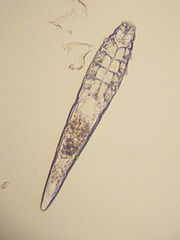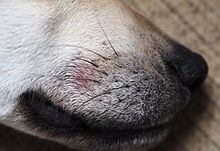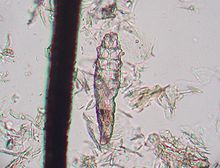Canine demodicosis
The canine demodicosis is a common, due to the excessive proliferation of the demodex Demodex canis induced, parasitic skin disease of dogs (Canidae). It can occur locally or all over the body. In older animals, demodicosis occurs only in connection with disorders of the immune system ; in young animals, the development of the disease is not fully understood. Demodicosis usually begins with hair loss and without itching. In the further course of a bacterial secondary infection, severe skin changes up to a purulent skin inflammation ( pyoderma ) can develop. The disease is diagnosed by microscopic evidence of the mites. The treatment is carried out with anti-mite drugs .
Cause of illness
Demodex canis is the main cause of demodicosis . Demodex canis is a slender, approximately 250 to 300 µm long and 40 µm thick mite that parasitizes in the hair follicles and sebum glands . There it feeds on sebum, tissue fluid and the naturally sloughed cells. These mites also occur in small numbers as commensals in many clinically healthy animals. The female mites lay eggs, which develop into the adult mites through a larval and nymph stage . The entire development cycle takes place in the hair follicles and lasts 20 to 35 days. Outside the host, hair follicle mites are unable to survive and die quickly as a result of dehydration. Hair follicle mites do not produce feces, but store metabolic degradation products in cells of the intestinal tract so that they hardly provoke an immune response.
More recently, other Demodex canis-like mites that are larger or smaller have been described. The shorter mite was called Demodex cornei , the longer one Demodex injai . Demodex cornei lives mainly on the skin surface and can occur in combination with Demodex canis . Demodex injai appears to be mainly in the sebum glands. However, D. injay and D. cornei may only be morphological variants of Demodex canis and not independent species.
Disease origin and spread
The Demodex mites are usually transmitted from the bitch to the puppy when they are just a few days old when they are suckling. However, this infection usually remains symptom-free. Transmission from dog to dog after the third day of life is considered unlikely. Demodicosis breaks out much later, when these mites multiply strongly. Affected young animals do not seem to have any disorders of the immune system, since they are not more sensitive to other diseases, one therefore assumes a reduced mite-specific immune competence. Only a temporary reduction in T-cell immunity is observed, but this may only be a consequence of the disease. In older animals, disorders of the immune system ( tumors , overactive adrenal glands , hypothyroidism , leishmaniasis , malnutrition and treatment with glucocorticoids , other immunosuppressants , progesterone or chemotherapeutic agents ) lead to demodicosis.
When the disease breaks out, the pathogen causes damage to the dog's hair follicles (up to 20 hairs per follicle) and a disruption of hair formation.
Demodicosis occurs worldwide. In contrast to the United States, there is no evidence of an increased tendency towards illness of certain dog breeds (breed predisposition) in Europe. In America, the English Bulldog , French Bulldog , Pug , Doberman , German Shepherd , Miniature Schnauzer and some terriers ( Pit Bull , West Highland White , Jack Russel , Staffordshire Bull Terrier ) are particularly affected. This is explained by the fact that in Europe immunocompromised animals (“carers”) are not used for breeding. In addition, there appears to be an individual genetic predisposition .
Transmission to other species does not normally take place as hair follicle mites are strictly host-specific. There are very few case reports that people living closely with sick dogs also showed symptoms , but there is still no talk of a zoonosis .
Clinical picture
Demodex canis infections
The first sign of demodicosis due to Demodex canis is usually hair loss ( alopecia ), which can only occur in localized areas or on the whole body (generalized). There is often increased sebum ( seborrhea ) or flaking on the hairless areas . In some cases, the latter symptoms can occur without hair loss. The damaged areas may later turn gray. Up to this stage there is usually no itching .
In young animals (younger than 18 months), the changes usually begin in the face area (“glasses formation”, lips , chin ) and / or in the limbs . This disease usually heals after a few weeks even without treatment, but it can also spread further and turn into generalized demodicosis.
In the further course of the disease, the clinical picture is characterized by a bacterial secondary infection , especially with staphylococci , more rarely also with Proteus , Klebsiella or Escherichia coli . There is a folliculitis , boils and excessive cornification ( hyperkeratosis ). Occasionally, this stage of the disease can also manifest as pustules . If the bacteria penetrate deeply into the skin, a purulent skin inflammation ( pyoderma ) develops with the formation of crusts and swelling of the lymph nodes . Canine juvenile cellulitis can be ruled out in young dogs by differential diagnosis .
Special forms are the infestation of the skin of the feet and ears. Infestation of the feet ( pododemodicosis ) manifests itself in reddening and swelling ( edema ) in the area between the toes ; in pronounced cases, granulomas and fistulas develop , so that the picture of chronic pododermatitis arises. The involvement of the external auditory canal ( otodemodicosis ) is mainly observed in generalized demodicosis and is characterized by a brownish secretion.
Infections with other Demodex mites
Demodex injai infections usually manifest themselves with increased sebum production ("oily skin"), poor hair quality with thinning hair and itching, especially on the back. Papules, pustules or " blackheads " can also occur. This form of demodicosis is mainly observed in terriers. Demodex cornei infections show up as reddening of the skin, flaking and pronounced itching.
Investigation methods
The diagnosis is made by detecting living mites in the hair follicles. To do this, a deep skin scraper usually has to be removed. Sample material for the subsequent microscopic examination can also be obtained by pulling out a hair pluck, squeezing out the hair follicles or sebum glands with a clamp or a skin biopsy . Skin biopsies are particularly useful in pododemodicosis with granuloma formation and breeds with very thick skin (English bulldog, Shar-Pei ), since a skin scraping of sufficient depth is rarely successful here. Overall, the number of mites detected in the skin scrap is greater than with the other methods.
Especially during therapy controls (see below), no whitening preparations with potassium hydroxide may be made, since then it is not possible to assess the vitality of the mites. The samples should therefore only be embedded in a drop of paraffin oil placed on a slide. It is recommended to leave the preparation for about 10 minutes before the examination, because the hair follicle mites then migrate out of the hair's root sheaths and are therefore more visible. It should be noted that individual hair follicle mites can represent a physiological finding, i.e. only a clear accumulation with the presence of eggs, larvae and nymphs in connection with the clinical picture is considered a clear diagnosis.
If the infestation is more severe, mites can also reach regional lymph nodes via the lymph vessels or can also be detected in the faeces through oral intake when licking.
In the case of secondary bacterial infections, it is recommended that the pathogen be detected by bacteriological examination and an antibiogram .
treatment
Local demodicosis in young animals resolves spontaneously in 90% of cases. Whether a treatment is useful or not is controversial in the literature. On the one hand, it is recommended to avoid generalization; on the other hand, it is recommended to wait for the possible generalization in order to be able to use it as a breeding exclusion criterion (see below). A local external (topical) treatment, for example by applying a gel with benzoyl peroxide , chlorhexidine or Rotenone, is usually sufficient. Benzoyl peroxide penetrates the hair follicles well, but has a strong drying effect and sometimes irritates the skin. A pronounced demodicosis should generally be treated with a full-body treatment.
In the past, regular washing with Amitraz had proven effective in both local and systemic demodicosis . However, some miniature dog breeds ( Chihuahua , Maltese ) are very sensitive to this active ingredient, so that its use is not recommended for them. In the case of severe infestation, a complete shear is recommended for long-haired dogs, as the active ingredient has to wet the skin well in order to be able to penetrate deep enough into the hair follicles. If there is a strong bacterial secondary infection, this must first be treated, e.g. B. by shearing the affected areas, cleaning with disinfecting washing solutions and systemic administration of antibiotics, since Amitraz should not be applied to larger wounds. From June 2009, a spot-on preparation with Amitraz was also approved for the treatment of demodicosis, which only needs to be applied every 14 days. In the case of local demodicosis in particular, a 14-day therapy check is useful in order to prevent treatment being discontinued too early and the risk of generalized demodicosis developing. An emerging treatment success can be seen from the decrease in the number of living mites, the increase in crippled mites and the decrease in larvae. Complete healing is indicated by hair that has grown back and the lack of evidence of living mites and is achieved with Amitraz in about 80% of cases. In about 40% of cases, side effects such as fatigue and itching occur, which can be reduced by increasing the dilution or reducing the frequency of treatment. Occasionally, more severe side effects such as unwillingness to eat, ataxia, and increased thirst and urination can occur. Since Amitraz also leads to an increase in blood sugar levels, its use in diabetic dogs is contraindicated . In the meantime (as of August 2020), preparations with amitraz are no longer permitted for dogs.
Systemic treatment with ivermectin , moxidectin, or milbemycin oxime is also well effective. These active ingredients are administered orally daily until the therapy has been successfully checked (see below ). It should be noted that some dog breeds and puppies under 12 weeks of age are very sensitive to some avermectins due to the inadequate blood-brain barrier (→ MDR1 defect ) and there is only one avermectin preparation approved for dogs in Germany with moxidectin. Treatment with milbemycin oxime is also possible in avermectin-sensitive dogs. However, it usually has to be carried out over a period of around 70 days and is therefore very cost-intensive. Recent studies indicate in generalized demodectic mange a good efficacy of isoxazoline as fluralaner , Sarolaner or Afoxolaner . Preparations of these three isoxazolines have been approved for the treatment of demodicosis since 2018 and 2019.
Due to significant side effects and the risk of poisoning, acaricides based on organic phosphoric acid esters are rarely used today.
Vitamin E can be administered as a support. If demodicosis occurs cyclically in bitches in connection with heat, castration should be considered. Treatment with glucocorticoids or progesterone is contraindicated in demodicosis.
In the case of secondary bacterial infection, in addition to mite control, local treatment with disinfecting solutions (benzoyl peroxide, chlorhexidine , povidone-iodine ) or antibiotics is indicated; in severe pyoderma, the systemic administration of antibiotics prior to the actual mite control is indicated.
Treatment prospect
The treatment is mostly successful in localized demodicosis. A successful therapy is assumed if no more living mites can be detected in two consecutive skin examinations at four to five different sites at intervals of two weeks. Severe, generalized forms and pododemodicosis can prove to be therapy-resistant, especially if there are irreparable disorders of the immune system or supporting primary diseases. The risk of recurrence drops significantly if the affected animal remains symptom-free for one year. In some animals, freedom from symptoms can only be achieved through lifelong administration of amitraz or ivermectin.
The American Academy of Veterinary Dermatology recommends excluding the affected animal and its parents and siblings from breeding in the event of generalized demodicosis of a young animal or recurrent demodicosis.
Literature and Sources
- Beat Bigler: Demodicosis. In: Peter F. Suter, Hans G. Nobody (Hrsg.): Internship at the dog clinic . 10th edition. Paul-Parey-Verlag, 2006, ISBN 3-8304-4141-X , pp. 368-369.
- Ch. Noli, F. Scarampella: Demodicosis of the dog. In: Practical Dermatology in Dogs and Cats . 2nd Edition. Schlütersche Verlagsanstalt, 2005, ISBN 3-87706-713-1 , pp. 238–244.
- St. Peters: demodicosis. Two new mite variants. In: Small animal specifically. 2/2002, pp. 4-9.
- D. Meyer, RS Mueller: The demodicosis of the dog. In: Veterinary practice. 2008; 36 (K), pp. 91-98.
See also
Web links
Individual evidence
- Jump up ↑ KV Mason: A new species of demodex mite with D. canis causing canine demodicosis: a case report. In: Ninth Proceedings, Annual Members Meeting of American Academy Veterinary Dermatology and American College Veterinary Dermatology, 1993, San Diego. P. 92.
- ↑ CE Desch, A. Hillier: Demodex injai: a new species of hair follicle mite (Acari: Demodecidae) from the domestic dog (Canidae). In: J Med Entomol. 40 (2003), No. 2, pp. 146-149.
- ↑ a b c d Tanja Töpfer: Diagnosis and therapy of demodicosis in dogs and cats . In: Kleintierpraxis Volume 65, 2020, Issue 8, pp. 444–459.
- ↑ a b c d e M. Shipstone: Generalized demodicosis in dogs, clinical perspective. In: Aust Vet J. Vol 78 (2000), No. 4, pp. 240-242.
- ↑ MN Saridomichelakis et al: Relative sensitivity of hair pluckings and exudate microscopy for the diagnosis of canine demodicosis. In: Vet. Dermatol. 18 (2007), No. 2, pp. 138-141. PMID 17355431
- ↑ Ch. Noli, F. Scarampella: Demodicosis of the dog. In: Practical Dermatology in Dogs and Cats. 2nd Edition. Schlütersche Verlagsanstalt, 2005, pp. 238–244.
- ↑ a b R.S. Mueller: Treatment protocols for demodicosis: an evidence-based review. In: Veterinary Dermatology. 15 (2004), No. 2, pp. 75-89.
- ↑ BR Holm: Efficacy of milbemycin oxime in the treatment of canine generalized demodicosis: a retrospective study of 99 dogs (1995-2000). In: Vet Dermatol. 14 (2003), pp. 189-195.
- ↑ Josephus J. Fourie et al .: Efficacy of orally administered fluralaner (BravectoTM) or topically applied imidacloprid / moxidectin (Advocate®) against generalized demodicosis in dogs . In: Parasites & Vectors . tape 8 , 2015, p. 187– , doi : 10.1186 / s13071-015-0775-8 , PMID 25881320 , PMC 4394402 (free full text).
- ↑ F. Beugnet, L. Halos, D. Larsen and C. de Vos: Efficacy of oral afoxolaner for the treatment of canine generalized demodicosis. In: Parasite. Volume 23, 2016, p. 14, doi: 10.1051 / parasite / 2016014 , PMID 27012161 , PMC 4807374 (free full text).
- ^ DW Scott et al.: Muller and Kirk's Small Animal Dermatology. 5th edition. WB Saunders, Philadelphia 1995, pp. 417-432.



